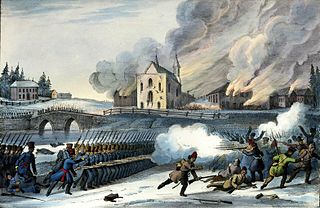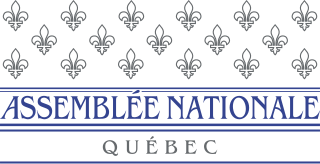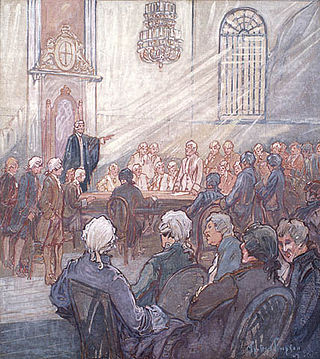
The Province of Canada was a British colony in British North America from 1841 to 1867. Its formation reflected recommendations made by John Lambton, 1st Earl of Durham, in the Report on the Affairs of British North America following the Rebellions of 1837–1838.

The Province of Upper Canada was a part of British Canada established in 1791 by the Kingdom of Great Britain, to govern the central third of the lands in British North America, formerly part of the Province of Quebec since 1763. Upper Canada included all of modern-day Southern Ontario and all those areas of Northern Ontario in the Pays d'en Haut which had formed part of New France, essentially the watersheds of the Ottawa River or Lakes Huron and Superior, excluding any lands within the watershed of Hudson Bay. The "upper" prefix in the name reflects its geographic position along the Great Lakes, mostly above the headwaters of the Saint Lawrence River, contrasted with Lower Canada to the northeast.

The Lower Canada Rebellion, commonly referred to as the Patriots' Rebellion in French, is the name given to the armed conflict in 1837–38 between rebels and the colonial government of Lower Canada. Together with the simultaneous rebellion in the neighbouring colony of Upper Canada, it formed the Rebellions of 1837–38.
Legislative assembly is the name given in some countries to either a legislature, or to one of its houses.

The Upper Canada Rebellion was an insurrection against the oligarchic government of the British colony of Upper Canada in December 1837. While public grievances had existed for years, it was the rebellion in Lower Canada, which started the previous month, that emboldened rebels in Upper Canada to revolt.

The National Assembly of Quebec is the legislative body of the province of Quebec in Canada. Legislators are called MNAs. The lieutenant governor of Quebec and the National Assembly compose the Legislature of Quebec, which operates in a fashion similar to those of other Westminster-style parliamentary systems. The assembly has 125 members elected first past the post from single-member districts.

This section of the Timeline of Quebec history concerns the events in British North America relating to what is the present day province of Quebec, Canada between the time of the Constitutional Act of 1791 and the Act of Union 1840.

The British North America Act, 1840, also known as the Act of Union 1840, was approved by Parliament in July 1840 and proclaimed February 10, 1841, in Montreal. It abolished the legislatures of Lower Canada and Upper Canada and established a new political entity, the Province of Canada to replace them.

The Legislative Assembly of Upper Canada was the elected part of the legislature for the province of Upper Canada, functioning as the lower house in the Parliament of Upper Canada. Its legislative power was subject to veto by the appointed Lieutenant Governor, Executive Council, and Legislative Council.
The 5th Parliament of Upper Canada was opened 2 February 1809. Elections in Upper Canada had been held in May 1808. All sessions were held at York, Upper Canada and sat at the Parliament Buildings of Upper Canada. This parliament was dissolved 1 May 1812 by the Administrator of the Government Isaac Brock who had been frustrated in his efforts to pass legislation preparing the colony for war with the United States.
The 13th Parliament of Upper Canada was opened 8 November 1836. Elections in Upper Canada had been held 20 June 1836. All sessions were held at Toronto.
The Legislative Assembly of the Province of Canada was the lower house of the Parliament of the Province of Canada. The Province of Canada consisted of the former province of Lower Canada, then known as Canada East, and Upper Canada, then known as Canada West. It was created by The Union Act, 1840.
The Legislative Council of the Province of Canada was the upper house for the Province of Canada, which consisted of the former provinces of Lower Canada, then known as Canada East and later the province of Quebec, and Upper Canada, then known as Canada West and later the province of Ontario. It was created by The Union Act of 1840. With the lower house, the Legislative Assembly of the Province of Canada, the two houses constituted the Parliament of the Province of Canada.

The Legislative Assembly of Lower Canada was the lower house of the bicameral structure of provincial government in Lower Canada until 1838. The legislative assembly was created by the Constitutional Act of 1791. The lower house consisted of elected legislative councilors who created bills to be passed up to the Legislative Council of Lower Canada, whose members were appointed by the governor general.
The Legislative Council of Lower Canada was the upper house of the Parliament of Lower Canada from 1792 until 1838. The Legislative Council consisted of appointed councillors who voted on bills passed up by the Legislative Assembly of Lower Canada. The legislative council was created by the Constitutional Act. Many of the members first called in the Council in 1792 had served as councillors in the Council for the Affairs of the Province of Quebec.
Robert Nichol was a businessman, judge and political figure in Upper Canada.
René-Joseph Kimber was a physician and political figure in Lower Canada and Canada East, in the Province of Canada. He represented Trois-Rivières in the Legislative Assembly of Lower Canada, as a member of the Parti patriote, although he opposed the use of force in the Lower Canada Rebellion. After the creation of the Province of Canada, which he opposed, he was the member for the district of Champlain in the Legislative Assembly of the Province of Canada. He was briefly a member of the Legislative Council, prior to his death in 1843.
Harmannus Smith was a physician, farmer and political figure in Upper Canada and then the Province of Canada. He represented Wentworth County in the Legislative Assembly of Upper Canada from 1834 to 1836 as a Reformer and then in the Legislative Assembly of the Province of Canada from 1841 to 1851. He served a six-year term in the Legislative Council of the Province of Canada, from 1858 to 1864.

The Parliament of the Province of Canada was the legislature for the Province of Canada, made up of the two regions of Canada West and Canada East.
The Parliament of Lower Canada was the legislature for Lower Canada. It was created when the old Province of Quebec was split into Lower Canada and Upper Canada in 1791.










